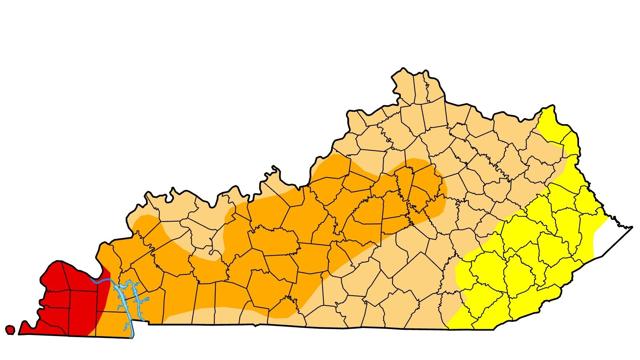
Continued dry weather has led to an expansion of both the area and severity of drought conditions in Kentucky, according to the weekly U.S. Drought Monitor report issued Thursday.
The eastern half of Pike County is the only area of the state not experiencing any drought conditions in the Oct. 27 report, less than 1% of Kentucky’s land area, compared to last week when that figure was 14%.
Much of eastern Kentucky, 16.87%, is considered “Abnormally Dry,” or D0 in the scale of drought severity that runs from D0 to D4. That is less than 1% higher than last week.
The area in “Moderate Drought,” D1, has shrunk, from 59.4% of the state to 43.11%, but that’s because of deepening drought conditions elsewhere.
“Severe Drought” conditions, D2, have expanded through much of central and western Kentucky, from 10.47% last week, to 37.14% in the latest report.
Conditions in the Jackson Purchase area of far western Kentucky have deteriorated to the point that an area of “Extreme Drought”, or D3, has been introduced there. All or parts of nine counties are included in that area.
The National Weather Service notes that many locations in Kentucky had ¼-¾” of rain earlier this week, but the U.S. Drought Monitor reporting period ends Tuesday morning, so that rain is not factored into the report. Much more is needed to relieve the situation, and that pastureland is showing signs of severe stress. In addition, at least 56 counties have enacted local burn bans, as of Thursday.
Currently, the forecast for the middle Ohio Valley calls for half an inch to an inch of rain this coming Sunday and Monday, October 30 and 31. That won’t end the drought situation but could help keep it from getting even worse.
The 6– to 10-day outlook calls for above normal temperatures and near normal precipitation.
The U.S Drought Monitor is produced jointly by the National Drought Mitigation Center at the University of Nebraska-Lincoln, the National Oceanic and Atmospheric Administration, and the U.S. Department of Agriculture.
By: Tom Latek, Kentucky Today








